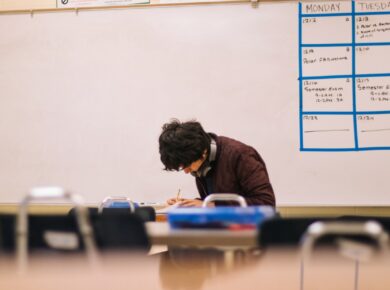Table of Contents
- Achievement Gap Definition
- What Impacts the Achievement Gap?
- What Can Be Done to Close the Achievement Gap?
- The Bottom Line
- Frequently Asked Questions (FAQs)
- What factors contribute to the academic achievement gap?
- Why is closing the achievement gap important?
- How can the achievement gap be closed?
- What role do teachers play in closing the achievement gap?
- How does socioeconomic status affect the academic achievement gap?
- Can technology help close the achievement gap?
The academic achievement gap is a persistent and troubling disparity in educational performance among different groups of students, often influenced by factors such as socioeconomic status, race, and geographic location.
This gap manifests in varying levels of academic success, as evidenced by standardized test scores, graduation rates, and access to advanced coursework. Understanding the roots of this inequality is crucial for fostering a more equitable education system.
This blog delves into the nature of the academic achievement gap, its underlying causes, and the multifaceted approaches needed to close it effectively.
Achievement Gap Definition
The term achievement gap is described as the educational attainment disparity among different communities of people. The achievement gap is present at all levels of education—from kindergarten to postgraduate studies.
This phenomenon harms students, as they will miss out on great career opportunities due to the lack of education and qualifications. On the other hand, society will suffer the lack of contributions that could otherwise be leveraged if there wouldn’t have been a gap present.
We can typically find evidence of the said gap in the school measurements of success, such as college enrollment rates, test scores, and dropout rates.
Who experiences achievement gaps?
According to the National Education Association, the following groups are the ones that experience notable academic achievement gaps:
- Students coming from low-income families
- Students with disabilities
- Racial and ethnic minorities
- English language learners
What Impacts the Achievement Gap?

There are a few factors which, when together, can contribute to this achievement gap in education. These factors fall into three categories:
1. District or school factors
Under district or school factors fall elements like:
- Unequal levels of school funding
- Inequitable distribution of qualified and experienced instructors
- Lack of articulated curriculum
- Lack of inclusion of the student’s background in the school culture and curriculum
- Inconsistent tracking process for students who need special education, are gifted, or should be placed in an advanced classroom
2. Classroom factors
Part of the classroom factors that help achievement gap to stay wide open are:
- Inferred bias and racism
- Lack of belief in the students’ ability or readiness to learn
- Inconstant use of assessments and interventions for struggling students
- Lack of development in culturally responsive teaching practices
3. Student factors
As for the student factors contributing to the achievement gap, here are a few of them:
- Stereotypes
- Social and experience gaps
- Internalized prejudices and beliefs on a community’s limited ability or opportunity
What Can Be Done to Close the Achievement Gap?

Now that we understand what the achievement gap is and the factors that contribute to it still being present, let’s get into what we can all do as a society.
Increasing instructional time
It’s a no-brainer, the more the students struggle, the more time they need with their teacher. That’s why increasing instructional time is one of the ways which, when used, can aid in closing the achievement gap.
The teacher determines the way the instruction is delivered; however, the instruction should target the needs of the students, their learning styles, and be explicit and scaffolded. It will surely be of high intensity, more repetitive, and be more detailed.
Monitoring progress on a monthly basis
Once the instructional time is increased, the teachers will have to continually track and monitor the students’ progress. Only by doing so can they know whether their students are doing well and where they could need improvement. Through different assessments, the instructors can identify their strong and weak areas and then intervene accordingly.
Fostering a relationship between school and the students’ families
One of the most critical steps to closing the achievement gap is for the school, parents, and the community to maintain a good relationship and cooperate with this common mission in mind. The family’s involvement, parents to be precise, will undoubtedly impact the students’ academic performance.
Motivating and engaging students
One way teachers can help close the gap is by using methods, technology, and lesson plans that actually match the students’ current skill set. Only by targeting the skills they already developed can they get motivated to build their way up from there. Otherwise, their engagement will suffer and decrease.
All in all, the achievement gap has ever since been present. While measures have been taken to put an end to it, this hasn’t still happened. One thing is for sure, we all have an obligation to do something in our power to help close this gap that might be affecting our future.
The Bottom Line
The academic achievement gap is a significant issue that continues to affect students from various backgrounds. Its roots are deeply embedded in factors such as unequal school resources, biases in the classroom, and socio-economic disparities.
Addressing this gap requires a multifaceted approach, including increasing instructional time, monitoring student progress, fostering collaboration between schools and families, and using tailored teaching strategies to engage students. While progress has been made, there is still much work to be done.
✅ Request information on BAU's programs TODAY!
If you’re passionate about making a difference in education and want to be part of the solution, explore our programs. Together, we can work towards creating a better future for all students.
Frequently Asked Questions (FAQs)
What factors contribute to the academic achievement gap?
Several factors contribute to the achievement gap, including socioeconomic inequality, access to quality education, inadequate school funding, cultural biases, language barriers, and disparities in parental involvement.
Students from low-income backgrounds or minority groups often face challenges such as less access to advanced coursework, under-resourced schools, and fewer extracurricular opportunities, all of which can affect their academic performance.
Why is closing the achievement gap important?
Closing the achievement gap is critical for ensuring equal educational opportunities for all students. By addressing the disparities, society can promote fairness, improve social mobility, and ensure that all students, regardless of background, are able to reach their full potential.
How can the achievement gap be closed?
Closing the achievement gap requires a multi-faceted approach, including:
-
- Equitable funding
- High-quality early education
- Culturally responsive teaching
- Parental and community engagement
- Targeted interventions
- Reducing systemic bias
What role do teachers play in closing the achievement gap?
Teachers play a central role in closing the achievement gap by providing high-quality instruction that meets the needs of diverse students. This includes differentiating instruction, being culturally responsive, setting high expectations, and fostering an inclusive classroom environment.
How does socioeconomic status affect the academic achievement gap?
Students from lower socioeconomic backgrounds often face challenges such as limited access to educational resources, a lack of extracurricular opportunities, and less parental support due to financial or time constraints. These factors can result in lower academic performance than students from higher-income families with more resources to support their learning.
Can technology help close the achievement gap?
Technology can significantly close the achievement gap by providing access to digital learning tools, resources, and platforms that may not be available in underfunded schools. Personalized learning through technology can also help address individual learning needs and provide students with opportunities to engage with content in different ways. However, it’s essential to ensure that all students have equal access to technology to prevent further widening of the gap.










